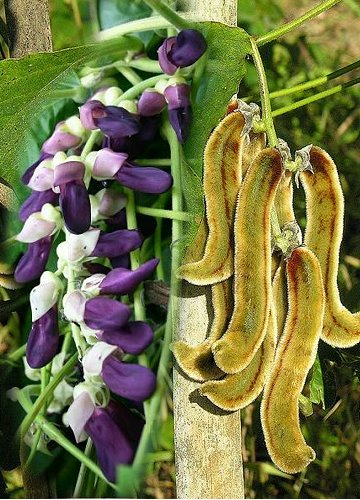
|
|
Velvet Bean (Mucuna pruriens).
Flowers and fruits.
|
Velvet Bean - Mucuna pruriens
Mucuna pruriens is a tropical legume native to Africa and tropical Asia and widely naturalized and
cultivated. Its English common names include velvet bean, Bengal velvet bean, Florida velvet
bean, Mauritius velvet bean, Yokohama velvet bean, cowage, cowitch, lacuna bean, and Lyon
bean. The plant is notorious for the extreme itchiness it produces on contact, particularly with the young foliage and the seed
pods. It has value in agricultural and horticultural use and has a range of medicinal
properties.
The plant a tropical legume. It is an annual climbing shrub with long slender
vines that can reach over 15 m (49 ft) in length. When the plant is young, it is almost completely covered with fuzzy hairs, but when older, it is almost completely free of hairs. The leaves are tripinnate, ovate, reverse ovate, rhombus-shaped or widely
ovate, ranging in size from 20-25 cm in length and 7.5-12.5 cm in
width. The sides of the leaves are often heavily grooved and the tips are pointy. In young M. pruriens plants, both sides of the leaves have hairs. The stems of the leaflets are two to three millimeters long. Additional adjacent leaves are present and are about 5 mm (0.20
in) long.
Its flowers are white, lavender
to dark purple and hang in long clusters. The flower heads take the form of axially arrayed panicles. They are 15–32 cm (5.9–12.6 in) long and have two or three, or many flowers. The accompanying leaves are about 12.5 mm (0.49 in) long, the flower stand axes are from 2.5–5 mm.
The plant also produces clusters of pods. The seed pods are about 10 cm long,
containing seeds known as Mucuna beans. The flowers, seedpods, and seeds are covered with
reddish-orange hairs. There are two forms of the hairs. The non-stinging hairs are
silky, while the stinging hairs, called Mucunain, produce an extremely itchy sensation when coming in contact with
them. The itch is caused by a protein known as mucunain. The species name
"pruriens" (from the Latin, "itching sensation") refers to the results to be had from contact with the seed pod
hairs. The seeds are flat and black, and when
matured, they have a glossy look to them. The dry weight of the seeds is 55–85 g (1.9–3.0
oz)/100 seeds.
The hairs lining the seed pods contain serotonin and the protein mucunain which cause severe itching when the pods are
touched. The calyx below the flowers is also a source of itchy spicules and the stinging hairs on the outside of the seed pods are used in itching
powder. Scratching the exposed area can spread the itching to other areas
touched. Once this happens, the subject tends to scratch vigorously and uncontrollably and for this reason the local populace in northern Mozambique refer to the beans as
"mad beans" (feijoes malucos). The seed pods are known as "Devil
Beans" in Nigeria.
In Central America, velvet beans have been roasted and ground to make a coffee substitute for
decades; its goes by the common name of "nescafé" in these regions, as well as in
Brazil, for this reason. It is still grown as a food crop by the Ketchi indigenous people in
Guatemala; the bean is cooked as a vegetable.
In Indonesia, particularly Java the beans are eaten and widely known as 'Benguk'. The beans can also be fermented to form a food similar to tempe and known as Benguk tempe or
'tempe Benguk'.
In Brazil the seed has been used internally for Parkinson's
disease, edema, impotence, intestinal gas, and worms. It is considered a
diuretic, nerve tonic, and aphrodisiac. Externally it is applied to ulcers. Velvet bean has a long history of use in Indian Ayurvedic
medicine, where it is used for worms, dysentery, diarrhea, snakebite, sexual
debility, cough, tuberculosis, impotence, rheumatic disorders, muscular pain,
sterility, gout, menstrual disorders, diabetes, and cancer. In India it is considered an
aphrodisiac, menstrual promoter, uterine stimulant, nerve tonic, diuretic, and blood
purifier.
In many parts of the world Mucuna pruriens is used as an important forage, fallow and green manure crop. Since the plant is a legume, it fixes nitrogen and fertilizes
soil.
Source:
https://en.wikipedia.org/wiki/Mucuna_pruriens
http://195.134.76.37/chemicals/chem_L-DOPA.htm
http://www.rain-tree.com/velvetbean.htm#.V5stz9EkodU
http://bioweb.uwlax.edu/bio203/2011/probst_emil/
